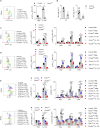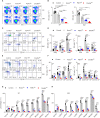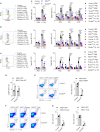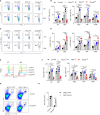Full Activation of Kinase Protein Kinase B by Phosphoinositide-Dependent Protein Kinase-1 and Mammalian Target of Rapamycin Complex 2 Is Required for Early Natural Killer Cell Development and Survival
- PMID: 33633735
- PMCID: PMC7901528
- DOI: 10.3389/fimmu.2020.617404
Full Activation of Kinase Protein Kinase B by Phosphoinositide-Dependent Protein Kinase-1 and Mammalian Target of Rapamycin Complex 2 Is Required for Early Natural Killer Cell Development and Survival
Abstract
The role of PI3K-mTOR pathway in regulating NK cell development has been widely reported. However, it remains unclear whether NK cell development depends on the protein kinase B (PKB), which links PI3K and mTOR, perhaps due to the potential redundancy of PKB. PKB has two phosphorylation sites, threonine 308 (T308) and serine 473 (S473), which can be phosphorylated by phosphoinositide-dependent protein kinase-1 (PDK1) and mTORC2, respectively. In this study, we established a mouse model in which PKB was inactivated through the deletion of PDK1 and Rictor, a key component of mTORC2, respectively. We found that the single deletion of PDK1 or Rictor could lead to a significant defect in NK cell development, while combined deletion of PDK1 and Rictor severely hindered NK cell development at the early stage. Notably, ectopic expression of myristoylated PKB significantly rescued this defect. In terms of mechanism, in PDK1/Rictor-deficient NK cells, E4BP4, a transcription factor for NK cell development, was less expressed, and the exogenous supply of E4BP4 could alleviate the developmental defect of NK cell in these mice. Besides, overexpression of Bcl-2 also helped the survival of PDK1/Rictor-deficient NK cells, suggesting an anti-apoptotic role of PKB in NK cells. In summary, complete phosphorylation of PKB at T308 and S473 by PDK1 and mTORC2 is necessary for optimal NK cell development, and PKB regulates NK cell development by promoting E4BP4 expression and preventing cell apoptosis.
Keywords: development; mammalian target of rapamycin complex 2; natural killer (NK) cell; phosphoinositide-dependent protein kinase-1 (PDK1); protein kinase B (PKB); survival.
Copyright © 2021 He, Zhao, Quan, Hou, Yang and Dong.
Conflict of interest statement
The authors declare that the research was conducted in the absence of any commercial or financial relationships that could be construed as a potential conflict of interest.
Figures







Similar articles
-
Phosphoinositide-dependent kinase 1 and mTORC2 synergistically maintain postnatal heart growth and heart function in mice.Mol Cell Biol. 2014 Jun;34(11):1966-75. doi: 10.1128/MCB.00144-14. Epub 2014 Mar 24. Mol Cell Biol. 2014. PMID: 24662050 Free PMC article.
-
Stage-specific requirement of kinase PDK1 for NK cells development and activation.Cell Death Differ. 2019 Oct;26(10):1918-1928. doi: 10.1038/s41418-018-0263-8. Epub 2019 Jan 8. Cell Death Differ. 2019. PMID: 30622306 Free PMC article.
-
mTORC1 and mTORC2 coordinate early NK cell development by differentially inducing E4BP4 and T-bet.Cell Death Differ. 2021 Jun;28(6):1900-1909. doi: 10.1038/s41418-020-00715-6. Epub 2021 Jan 18. Cell Death Differ. 2021. PMID: 33462410 Free PMC article.
-
The PI3K-PDK1 connection: more than just a road to PKB.Biochem J. 2000 Mar 15;346 Pt 3(Pt 3):561-76. Biochem J. 2000. PMID: 10698680 Free PMC article. Review.
-
PDK1 and PKB/Akt: ideal targets for development of new strategies to structure-based drug design.IUBMB Life. 2003 Mar;55(3):117-26. doi: 10.1080/1521654031000115951. IUBMB Life. 2003. PMID: 12822887 Review.
Cited by
-
Hippo kinases Mst1 and Mst2 maintain NK cell homeostasis by orchestrating metabolic state and transcriptional activity.Cell Death Dis. 2024 Jun 19;15(6):430. doi: 10.1038/s41419-024-06828-x. Cell Death Dis. 2024. PMID: 38898027 Free PMC article.
-
The mTORC2 signaling network: targets and cross-talks.Biochem J. 2024 Jan 25;481(2):45-91. doi: 10.1042/BCJ20220325. Biochem J. 2024. PMID: 38270460 Free PMC article. Review.
-
Akt isoforms in the immune system.Front Immunol. 2022 Aug 23;13:990874. doi: 10.3389/fimmu.2022.990874. eCollection 2022. Front Immunol. 2022. PMID: 36081513 Free PMC article. Review.
-
Eomesodermin spatiotemporally orchestrates the early and late stages of NK cell development by targeting KLF2 and T-bet, respectively.Cell Mol Immunol. 2024 Jul;21(7):662-673. doi: 10.1038/s41423-024-01164-8. Epub 2024 May 13. Cell Mol Immunol. 2024. PMID: 38740922 Free PMC article.
References
Publication types
MeSH terms
Substances
LinkOut - more resources
Full Text Sources
Other Literature Sources
Molecular Biology Databases
Miscellaneous

